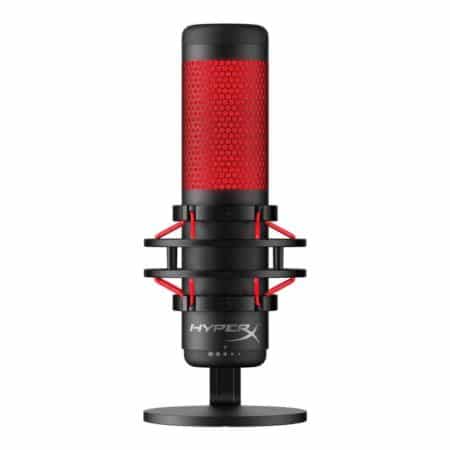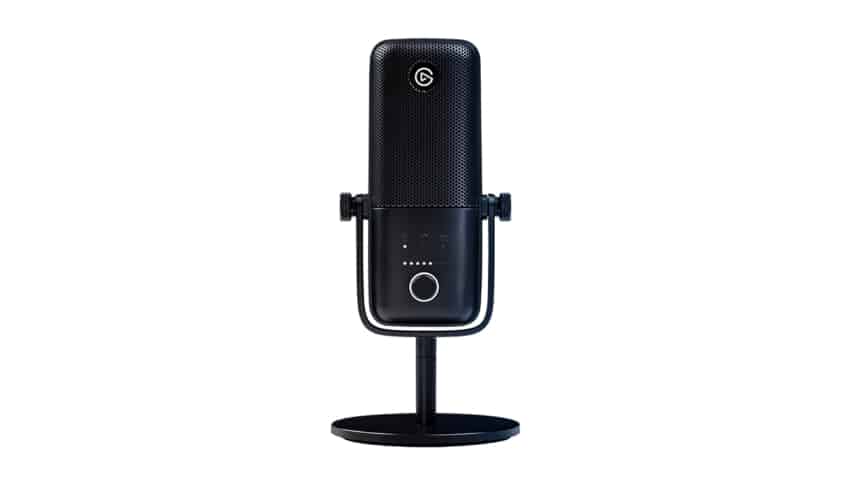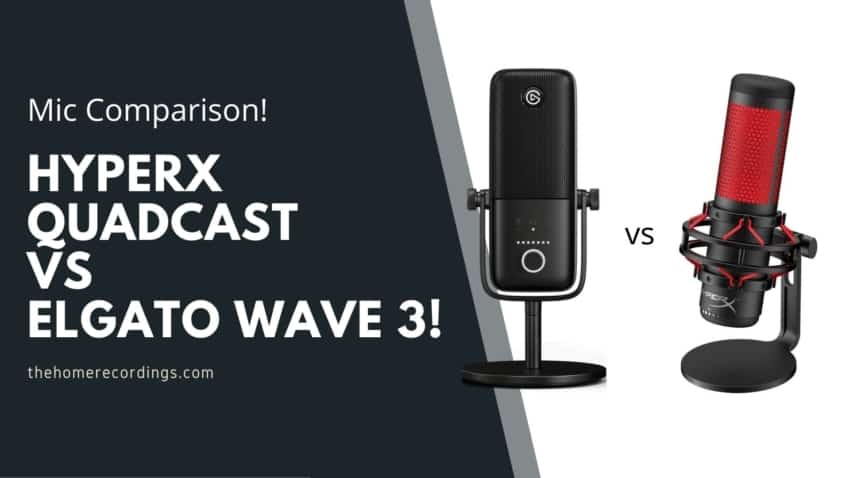Last updated on December 29th, 2023 at 09:57 pm
The HyperX Quadcast has been out for quite a long time now while the ElGato Wave 3 is a fairly new mic.
Both microphones have been designed with gamers and streamers in mind, and I have to say that one of them clearly outshines the other.
So, without any further ado, let’s get started!
Differences
Both microphones are designed for gamers and streamers, and the HyperX Quadcast offers Cardioid, Omni & Bidirectional, as well as Stereo polar patterns, making it a very versatile microphone.
The ElGato Wave 3 only features a cardioid polar pattern, but the audio quality is much better and it also features the Clipguard, which makes it the best microphone for streaming & Gaming.
Let’s get into the specifics of each microphone, their features, and more!
HyperX Quadcast

So, firstly this microphone is clearly aimed towards gamers who want to stream their gameplay, or just YouTubers in general, because of the way it looks.
Of course, it can be used to do almost anything since it’s a very versatile microphone, but even though I like its appearance, it’s definitely not as professional-looking as some other microphones, including the ElGato Wave 3.
The HyperX Quadcast comes with the following pickup patterns: Cardioid-, Omni-, Bi-directional-, and stereo patterns.
It comes attached to a desk-stand that also has a built-in shock mount, and this is definitely a really nice bonus to have since it will either completely avoid picking up unwanted vibrations coming from the desk, or at least reduce them significantly.
Note: The ElGato Wave 3 doesn’t come with a built-in shock mount.
On the back of the microphone you’ll have access to the USB connection and to a headphone jack that lets you do zero-latency monitoring.
Once the microphone is connected and working, it will light up in a really nice red color (I used to think that this was the color of the microphone itself, but it’s actually thanks to the internal lighting).
On the top of the microphone you’ll find a touch-sensitive “Mute” button; When the mic is muter, the background light inside the microphone will turn off.
This is a really nice feature to have for two reasons; Most USB microphones don’t have this option and you need to turn the Gain dial all the way down if you want to mute it, and getting the exact same level afterwards can be tricky.
This way you only need to unmute it and you’re back recording at the exact same level.
The other reason is that since the microphone only lights up when it is recording, you’ll have visual feedback when it’s muted or not.
Now, I mentioned that it comes with four different pickup patterns, and while they all may have their place, you’re probably going to be using the cardioid one the most, especially if you’re doing voice-over, singing, Streaming, etc. since it’s designed to only pick up what is right in front of the mic.
The Omni polar pattern is designed to record everything surrounding it, and if you want to do a podcast and only have this microphone, then this would be the polar pattern of choice.
Lastly, the Stereo and Bi-directional patterns are identical, with the only difference being that the bi-directional picks up sound from the front and back, while Stereo picks up sound from both sides.
If you’re interviewing someone, then Bi-directional is the best one, while if you want to record and acoustic guitar for example, stereo would be best.
How does it perform?
For spoken word, voice over, streaming, etc. I found it to be a good microphone; it sounds full and I needed to do little-to-no editing after the recording was done in order to get a professional sound out of it.
For music, on the other hand, I don’t recommend it.
I recorded my acoustic guitar with it and the Stereo Pattern did work quite well, even though it lacked a bit in the lower end.
With the Cardioid pattern however, it sounded way too boomy for my taste, which is kind of the opposite of what happened with the stereo pattern.
Another issue I found was with the pop filter, which is designed to reduce unwanted plosives when you’re talking;
It is definitely far from the best and if you’re going to be speaking straight into the microphone, then I’d highly recommend purchasing an external pop filter, otherwise get ready to re-record everything multiple times.
One other issue popped up when I mounted it on a regular mic-stand using the adapter; there’s little to no room between the mic and the mic-stand and this creates unnecessary pressure on both the USB- and headphone cables…
So, imagine how long those cables will last? Not to mention the USB and headphone connectors themselves.
Now, one huge pro of this microphone is the “Mute” button on the top, which is something I wish more USB microphones would feature, and also that it comes with a shock mount, so yes, there are some really good things that HyperX did right here.
Lastly, this microphone is marketed towards gamers mostly, so why on earth does it need four polar patterns? You only need a Cardioid one as a gamer/streamer and the cost could’ve been significantly lower if they didn’t include the extra three.
This is definitely a con, but some people may use those extra patterns sometime.
What comes in the Box?
- The HyperX Quadcast Microphone
- USB Cable
- Mic Stand adapter
Features
- Tri-capsule array: three condenser capsules inside
- Multiple pattern selection: cardioid, stereo, omnidirectional and bidirectional
- Gain control, mute button, zero-latency headphone output
- Good for podcasting, voiceovers, game streaming, interviews and conference calls
- Plug ‘n play: Mac and PC compatible
- Desk stand included (already attached to the mic)
- Mic-Stand adapter (may hurt the cables)
Specifications
- Polar Pattern; Cardioid, stereo, omni- and bidirectional
- Frequency Response: 20Hz- 20kHz
- Sample Rate: 48kHz/16-bit
- Sensitivity: -36dB
- Weight: 254g
Find out more about the HyperX Quadcast here.
Elgato Wave 3

Now, I have to say that I didn’t have high expectations for this mic at all, but I definitely was impressed since for once a company decided to focus on what the users actually need, instead of just adding unnecessary features to inflate the price.
So, if you’re a gamer, YouTuber, Streamer, etc., this microphones probably has everything you need.
As far as the build quality goes, it’s nothing to brag about since the body is made out of plastic which does feel a little cheap, and the U-bracket that attaches the mic to the desk-stand is also made of plastic.
The mesh grille is metal, but it has a bit of give to it, which isn’t ideal as well.
Even though it should last you a very long time if taken good care of, the overall build quality is lacking, and I wouldn’t recommend dropping this mic or anything similar.
However, and even despite this, I still think that it’s probably the best microphone for Gamers/YouTubers out there, and here are the reasons for that:
- It features a “Clipguard”, which when enabled will prevent clipping or saturation if you signal gets too loud; like for example if you scream.
- It also comes with a high-pass filter that can be enabled to remove a bit of the low end, and this can come in handy when you want to better deal with the proximity effect (basically, the closer you get to the mic, the more low-end you will hear, and the high-pass filter helps deal with this).
These features can be accessed through the Wave Link software that comes with the mic and are definitely something that the gaming and streaming community desperately need to be able to produce content with good sound quality, and it’s refreshing to see that a company has finally taken notice.
Of course, this is very intentional since the Elgato Wave 3 was designed with gaming and streaming in mind, where extra microphone patterns really don’t serve any purpose.

Lastly, it features a Mute button, gain control, headphone volume, and the mix control between the computer’s playback and zero-latency monitoring.
Note: If you want to check out my full written review of the ElGato Wave 3, you can find it here.
How does it perform?
As far as spoken word goes, which is what this mic was mainly designed for, it’s absolutely great since there are no prominent frequencies poking there head out anywhere, plus if you want to get rid of some of the low end, you can always engage the high pass filter.
The Clip Guard is definitely a huge plus here, since there will be no more clipping/distorting, which is definitely something that streamers have to del with on a daily basis.
There is one issue though, and it’s that the desk stand doesn’t really help reject any noise coming from the desk itself, like for example if you tap your fingers on it, the vibration coming from the keyboard, or basically bumping against the desk.
In that case, I would much rather recommend a boom arm with a shock mount to absorb those vibrations.
Now, what if you want to record music with it?
Well, for singing it does more than fine!
As far as recording instruments go, it did a decent job at recording acoustic guitar, and the HPF came in handy here since it allowed me to angle it more towards the sound hole and still get a good recording.
Also, I have to say that I was pleasantly surprised at how well it managed to capture the sound of my electric guitar cabinet, even with distortion.
Still, I think that I would much rather use a good dynamic mic for this, but hey… it works!
Finally, the Wave Link software that comes with this microphone is where you can enable the Clip Guard and the High Pass filter, plus it lets you mix the audio signals from different sources in the PC, like Google Chrome, etc. and decide how high or low the volume of every source will be on the stream.
What comes in the Box?
- Elgato Wave 3 Microphone
- USB Cable
- Mic Stand adapter
Features
- ClipGuard
- High Pass Filter
- Mute Button
- Wave Link Software for more in-depth control of the audio
Specifications
- Polar Pattern; Cardioid
- Frequency Response: 20Hz- 20kHz
- Sample Rate: 48kHz/96kHz – 24-bit
- Max SPL: 120dB
- Sensitivity: -25dBFS
- Weight: 280g
Which one is right for you?
I have to say that I’m not a fan of microphones that have too many bells and whistles: I want a microphone that does one thing properly, and in this case I think the ElGato Wave 3 is a much better choice.
The recording quality is superior and it features the Clip Guard, which is fantastic for streaming and gaming.
If I had to choose between one of the two, I’d go with the ElGato Wave 3, no questions asked.
Conclusion
I just mentioned that I’d much rather have the ElGato wave 3 over the HyperX Quadcast, because of the audio quality and the included software, even though it’s made of plastic and much more flimsy than the HyperX Quadcast, but most people won’t be able to take advantage of the four different polar patterns of the Quadcast, which means that you’ll be paying more for something you won’t use.
I prefer having a cardioid microphone that records well, and if you truly need one with multiple polar patterns for recording a podcast, interview a guest, etc. then I’d much rather go with the Blue Yeti because of the way it looks.
Having the Quadcast on an interview doesn’t really look all that serious.
I hope this information was useful!
Have a wonderful day!
